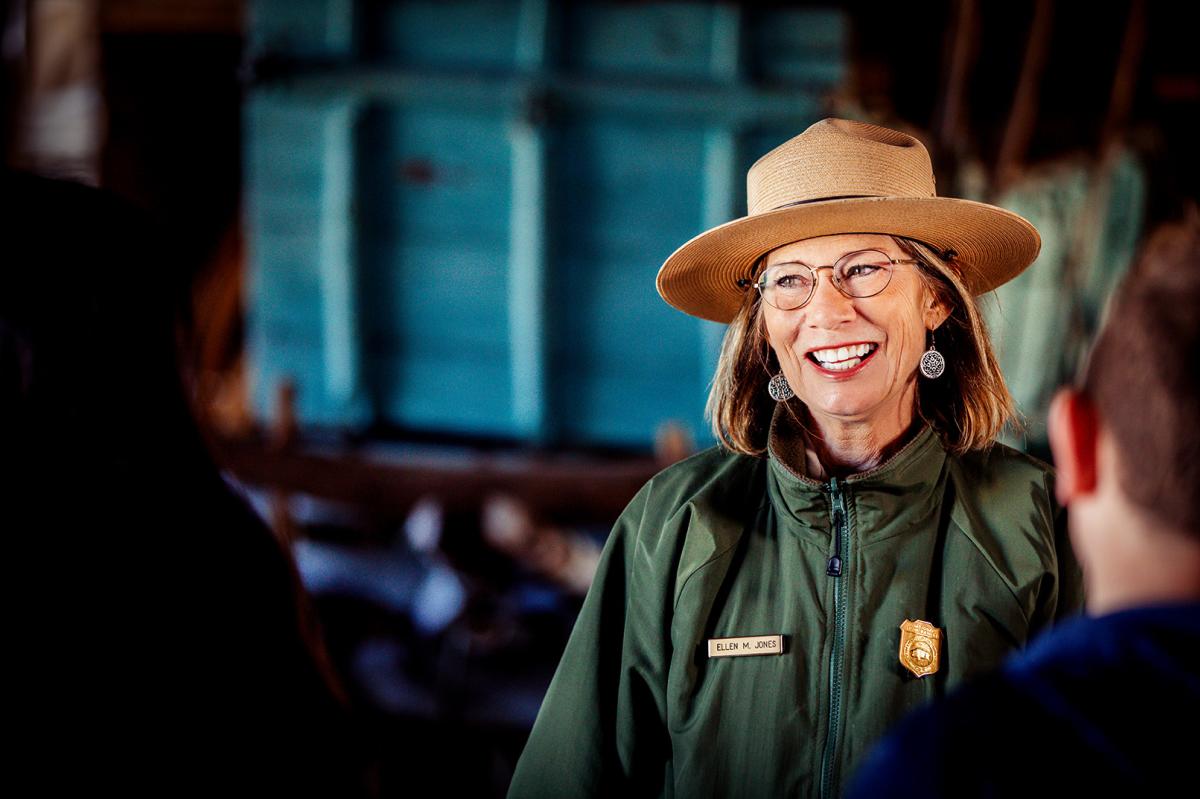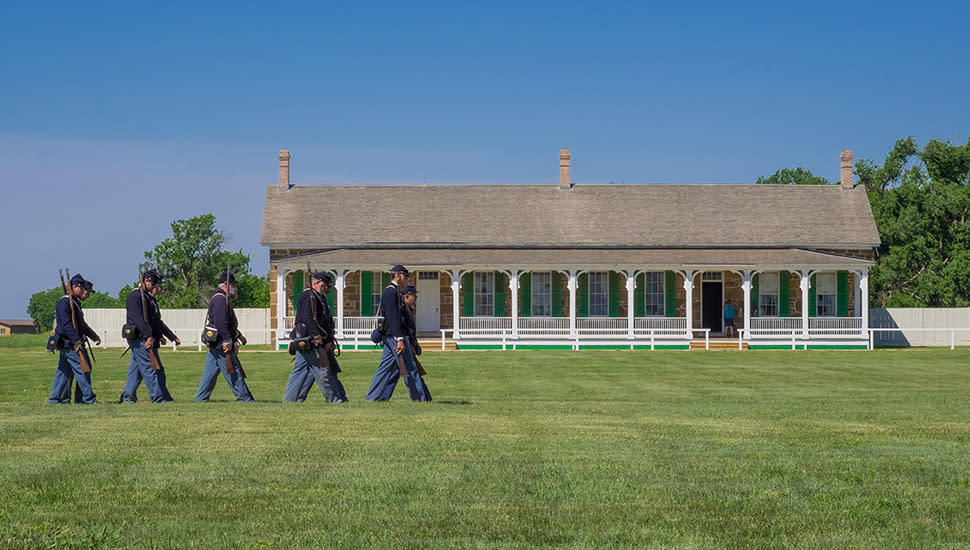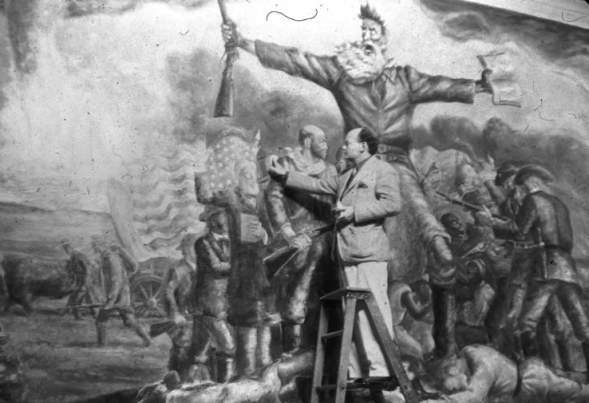A new permanent exhibition highlights the role and the legacy of a military outpost on the Santa Fe Trail
Fort Larned National Historic Site sits amid fields and along a meandering line of trees that clings to the banks of the Pawnee River in rural Pawnee County, approximately 7 miles west of Larned. It is a quiet, peaceful place, although it was for a brief time at the center of American migration, commerce and a bitter war of settlement and dislocation. The story of the fort’s connection to the Santa Fe Trail, its role in pivotal events and its sudden consignment to a peripheral place in the nation’s history continues to be preserved and told to visitors throughout the year.
First named Camp on Pawnee Fork in 1859 because of its location on the Pawnee tributary of the Arkansas River, the military post was one of a series of military forts along the heavily traveled Santa Fe Trail to assert American settlement and commerce.
“The Santa Fe Trail was the main artery of commerce right through the area,” explains George Elmore, the site’s chief ranger. “The fort was established for defense and protection of the U.S. mail routes on the trail. At the beginning, the soldiers at the fort protected the entire route halfway to Fort Union in Santa Fe. Later on, there was an average of about 300 men in the garrison, and at any time about half of them were out on the trail. The military was basically like the highway patrol of today; they went up and down the trail to patrol and keep it safe, but they could not guard everything that went down the trail.”
As the United States fought the Civil War (1861–1865), the regular and volunteer troops remaining at Fort Larned became increasingly drawn into military conflict with Native people, particularly during what is known as the Indian War of 1864. From 1867 to 1868, the fort’s original sod and adobe structures were upgraded to the more durable native sandstone buildings still seen today. But just as the fort took on a more solid presence, its relevance as a fortification along the Santa Fe Trail decreased in the 1870s as railroad lines absorbed passengers and commerce and reshaped routes into the American West.

The story of the creation of Fort Larned, the lives of the troops who lived there, the Native communities who sometimes fought and sometimes traded with them, the ecosystem and the cultures that grew up around the fort is detailed in a new multimedia, multicultural permanent exhibition that opened in January 2020.
“It is a total overhaul, very much a different type of museum than we had before,” says Elmore. “It is based on all the cultures that were involved in the history of the area of the fort, including the Spanish, the Buffalo Soldiers and the Native people. In fact, these exhibits were created with representatives of the tribes—there are a lot of little, subtle things that they contributed to, such as the fact that images of the Plains tribes people such as the Comanche, Cheyenne, Arapaho or Lakota should be depicted as standing in a circle since they are ‘people of the circle.’”
The Fort Larned includes nine original native sandstone structures housing saddler, blacksmith, carpenter and wheelwright shops, the enlisted men’s barracks, opulent officers’ quarters, the post-hospital, a commissary, and warehouses. A block house and a massive brick oven for baking have both been reconstructed and are historically accurate.
Visitors may explore the fort’s grounds and historic buildings at their own pace, according to Elmore.
“If you get the app on your cell phone, you can walk around on your own and get a tour that way,” Elmore says. The app also includes a guided tour of the fort’s one-mile History and Nature Trail.

Living History at Fort Larned
The sound of a blacksmith hammering in his shop, the smell of warm bread in the bakery, and the sight of soldiers cleaning their weapons during Living History Events at Fort Larned National Historic Site provide an insightful look into daily life on a frontier military post in the mid-19th century.
“You can walk in and see empty buildings anytime, but to walk in and actually get the smells and the sights and sounds of an active military post, it just brings the whole thing to life; it brings all our senses into it,” says Chief Ranger George Elmore of the National Park Service. “Some people say it’s like walking into the past. You still get that isolation feeling out here, just like if you were traveling the trail in the 1860s and walked into the fort.”
Prior to the pandemic, Living History Events at Fort Larned occurred on Memorial Day and Labor Day weekends, with a smaller event on Independence Day. Elmore says plans are to resume hosting these gatherings when health authorities declare it safe; therefore, this May’s Memorial Day event depends on the coronavirus situation at the time. For that reason, the Fort’s website should be checked for the most current information before traveling.
Typically, the larger weekend Living History Events at the fort bring 20 to 30 infantry and cavalry re-enactors from Kansas and units from as far away as Denver and Dallas, according to Elmore. Dressed in period military attire, they “live” in the barracks for the weekend as guardians of history.
“Instead of walking in and seeing a bed, you see soldiers sitting on beds and polishing brass on their uniforms,” Elmore says. “You might think that out in the middle of Kansas, nobody would care, but the Army regulations were the same as if the troops were stationed in Washington D.C.—they inspected those guys every day. It’s a great visual.”
The historic reenactors perform duties at the fort, which contains nine original native sandstone buildings around a parade square, typical of frontier forts in that time period. Bread is baked in a massive reconstructed brick oven that takes three days to heat to 360 degrees. Cavalry soldiers care for their horses and use period tack. The traditional 19th-century Army flag-lowering ceremony ends each day; frontier posts typically flew a 36’ by 20’ garrison flag so it could be seen for miles, assuring trail travelers that the United States Army was nearby.
Volunteers and staff portray the roles of civilians at the fort, such as a blacksmith forging a tool and an officer’s wife dressed in finery as she sits reading in her lavish quarters.
On each of the three days of the event, special activities include artillery and rifle firing, other demonstrations such as blacksmithing, quilting and leatherworking, and programs on various aspects of the fort and its history.

Visiting Fort Larned
Health precautions in response to the pandemic will affect which events and areas of the museum will be open to visitors at any given time. For the past months, the site itself has been open, with full access to the grounds and nature trail, but the education center has been periodically closed. Visitors should go online or call in advance of a visit in order to plan activities or schedule a guided tour.
nps.gov/fols/index.htm | (620) 285-6911
Ways to Stay Connected
Read more about Kansas History
View ALlBlack History Trail of Geary County
Mar 08, 2024Jim Sands, President of the Black History Trail of Geary County / Photography by Nick Krug A county… Read More
Quindaro: A Great, Nearly Lost City of Free Peoples
Mar 07, 2024Photography by Andrea LaRayne Etzel & Carter Gaskins Quindaro was an abolitionist frontier city… Read More
From the Archives: Remembering John Steuart Curry
Jan 15, 2024Editor's Note: This article was originally published in the winter of 1992 by Don Lambert… Read More
From the Archives: Birth of the Helicopter
Jan 08, 2024Editor’s Note This article was originally featured in the winter issue of 1983 by Joan L… Read More
From the Archives: Kansas Outlaws
Oct 05, 2023The Sunflower State is known for its famous lawmen—but its infamous villains are legendary as… Read More










